
Alonnisos: Here, time-lost villages cling to hillsides and Aleppo pine forests dive to cliff-rimmed bays washed by a glassy turquoise sea.Credit: iStock
Scattered across the teal-blue sea as if the gods had dropped their marbles, the Greek islands are like nowhere else on Earth. They are the stepping stones to sun-dappled freedom, thyme-scented breezes, drowsy olive groves and retsina-soaked nights under a brilliant frieze of stars.
From that first side-street pitta souvlaki, with a stray cat rubbing against your ankles, and that first icy Mythos on a white-pebble cove, the colossal weight of the world slips from your shoulders the minute you arrive.
There is something elemental about these islands: the light bouncing off white walls; the warm, silky sea; the wind and waves. After a few days, you’re breathing deeper, moving slower, tuning into forgotten biorhythms.
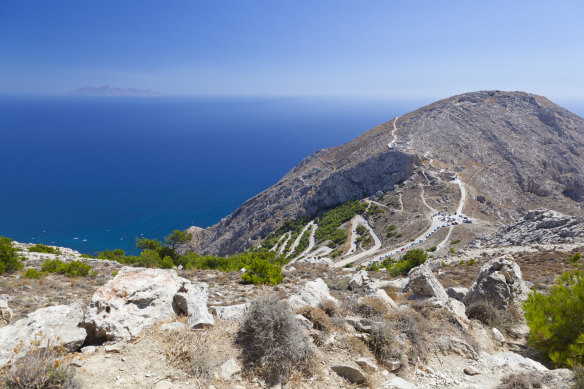
Anafi lives up to its name, which means “revelation”.Credit: Getty Images
You become downright lazy. Suddenly, it’s an effort to shuffle a few feet from the sunbed to the taverna for a frappe, to the sea for a dip, or to those ancient ruins of Homeric legend. Tomorrow. Siga, siga – slowly, slowly, the magic is working.
And what magic. For what could be more exciting than opening a dog-eared map and tracing a curious finger over its 6000 islands – some inhabited, some little more than specks of rock – then high-tailing it to Athens, hopping on an old bone-shaker of a ferry and alighting on one with a name you’ve never heard of.
There are popular isles with crowds and cruise boats, of course, like Crete, Corfu, Mykonos, Rhodes, Kos and Santorini. And then there are the likes of Symi, Sifnos and Serifos – islands that were once totally untouched by tourism, but have gradually seen ferries multiply and prices rise as a trickle of foreign visitors became a gush.
But there is a third category – a Greece beyond the sunset-hogging Instagrammers, two-for-one-cocktails and sirtaki dancing on tables.
The nostalgia-inducing Greek island dream still exists. Do the legwork, and you’ll find under-the-radar islands where you can still rock up on a ferry and book a sea-view room with change from $100.
You’ll still find remote villages with one-pan tavernas, where families bring slow-cooked lamb, aubergine fritters and fish so fresh it has just leapt out of the sea to the table. And you’ll still find trails to blue-domed, incense-misted chapels; trails to half-moon coves; trails threading high through pastures into cloud-wisped mountains.
After doing the Greek salad-tzatziki-beach thing to death, you swear it’ll be Italy next year – but deep down, you know the tug of your new favourite undiscovered Greek isle is too strong. You’ll be back. Oh, and that week you booked off? Make it two. The Greeks don’t rush – neither should you.
Ikaria
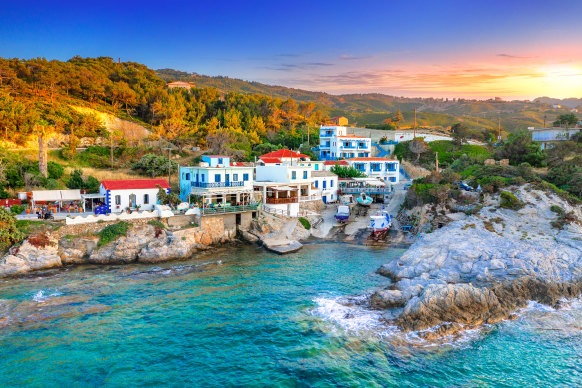
The village of Gialiskari, Ikaria.Credit: iStock
There’s magic in the air on wild, savagely beautiful Ikaria in the eastern Aegean. This is where the party-loving, wine-swigging god Dionysus was born, and where Icarus fell and drowned after flying too close to the sun. For much of history, islanders hid from pirates in giant rock houses. Reclusiveness bred resilience, and today Ikaria is one of the world’s five “blue zones”, with an exceptionally high number of centenarians. Sulphur-rich hot springs and a diet rich in wild greens (try hortopita pies) and natural wines contribute to its longevity, but there’s also something untouchable. Ikaria is the classic Greek package but with the drama turned up. The winds and waves are more powerful, the granite peaks higher than most other islands, punching up to the 1037- metre-high Aetheras. You need to be as nimble as a goat to hike the monopatia (old footpaths) dipping into the island’s thickly forested, boulder-scattered mountains, and the narrow roads swinging precariously along cliff tops are life-flashing-before-your-eyes stuff. But it’s all worthwhile for heavenly bays like Seychelles Beach, with white pebbles sliding into a brilliantly azure sea.
Essentials Take the Dodekanisos Seaways ferry from Kos (three hours and 20 minutes, $21); Ikaria Studios in Manganitis has simple studios from $63 a night. See visitikaria.gr; 12ne.gr/en
Amorgos
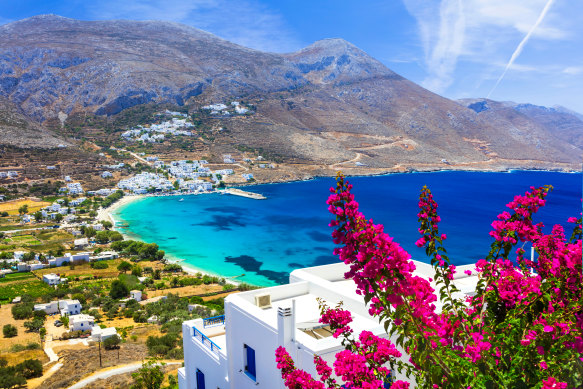
Beautiful Aegialis Bay, Amorgos.Credit: iStock
Like a seahorse drifting in the deep-blue Aegean, the island of Amorgos, in the eastern Cyclades, presses all the fantasy Greek island buttons. My, my, is it lovely, with a road whipping along its mountainous spine, cliffs dropping to waters of stained-glass blue, and alley-woven villages where bone-white houses glimmer in the heat, cats doze in doorways and every bend is a photo op.
Whether you take the slow boat from Athens or faster Super Jet from Mykonos, you’ll be bewitched as soon as you set foot on the island, which starred in Luc Besson’s 1988 film, The Big Blue. But despite its cinematic looks, tourism here is low-key, and still almost exclusively made up of French yachties, drawn by the star status of Besson’s hit. When you can tear yourself away from ravishing beaches like Kalotaritissa Bay, with its blonde sand and cerulean waters, check out the village of Chora, a medieval knockout with its windmills and Venetian castle, or puff up 300 steps to Panagia Hozoviotissa, the island’s cliff-hugging, white-walled monastery.
Essentials Seajets ferries run from Athens-Piraeus to Katapola on Amorgos (seven hours, $121) or take the Super Jet from Mykonos (two hours 10 minutes, $140). In the island’s north-west, Vigla Hotel has doubles from $171. See seajets.com; vigla-amorgos.com
Alonnisos
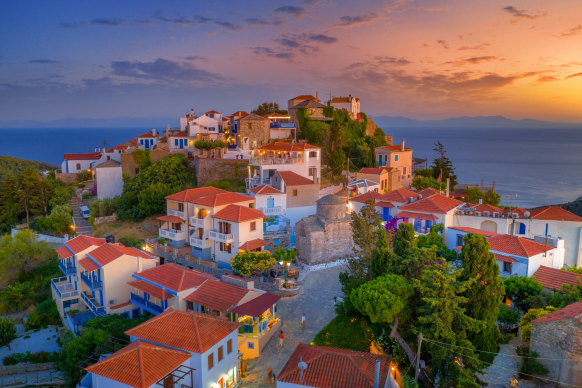
The old village of Chora in Alonnisos island.Credit: iStock
While everyone raves about Skopelos of Mamma Mia! fame, they whisper more quietly about neighbouring Alonnisos. But this insanely pretty island in the northern Sporades will make you want to sing out loud. Here, time-lost villages cling to hillsides and Aleppo pine forests dive to cliff-rimmed bays washed by a glassy turquoise sea. Cicadas strum on trails whipping through vineyard, orchard and olive grove; tiny chapels glitter with icons; and curious goats eye up your lunch at pretty beachfront tavernas. With its cat-patrolled lanes, pavement cafes and blue-shuttered houses, Chora, the old capital, is delightful. But it’s on the rockier, unscathed west coast that you’ll feel the pull of the wild. Nature is the big draw: see dolphins, turtles and the rare Mediterranean monk seal at the marine park; dive down to a fascinating fifth-century shipwreck at Peristera’s underwater museum, or hunt for the wild herbs that have made the island a centre of homoeopathy.
Essentials Seajet ferries run from Skiathos (one hour 45 minutes, $23). In an olive grove near Glyfa beach, Ilya Botanic Suites has slickly designed suites with spa baths or hot tubs from $192. See ilyabotanicsuites.com
Anafi
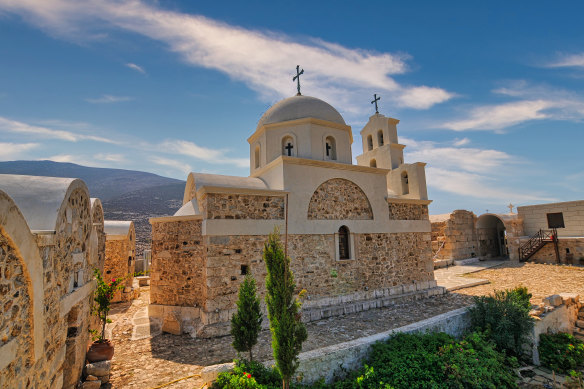
Traditional orthodox monastery, Anafi Island.Credit: iStock
All but a stone-skim away from Santorini, Anafi lives up to its name, which means “revelation”. Greek myth has it that Apollo, god of light, created this gorgeous speck of an island to shelter the Argonauts from a fierce storm. More likely, however, is that it bubbled up during the Minoan eruption of Santorini in 1600 BC. So far, so mysterious. And that sums up Anafi in a nutshell. If you want to vanish for a spell, where better to do so than on this wild, pin-drop peaceful island, with houses of dazzling white, water of searing blue and rockscapes stippled with gnarly olives and prickly pears. Flop on tamarisk tree-backed, turquoise sea-lapped swathes of golden sand like Klisidi, Katsouni and Roukounas and Katalimatsa.
Catch south-coast sunsets of brilliant burnt orange and soft pink. Or for a staggering view, trek to the top of the 457-metre Kalamos rock. Rising out of the sapphire sea like a sleeping dragon, it’s the second-largest monolith in the Mediterranean after Gibraltar.
Essentials Hellenic Seaways runs fast boats from Santorini (one hour, $20). Other ferry companies include Blue Star Ferries and Seajets. Apollon Villa Hotel has bright, sea-view studios from $122. See hellenicseaways.gr; bluestarferries.com; apollonvillagehotel.com
Nisyros
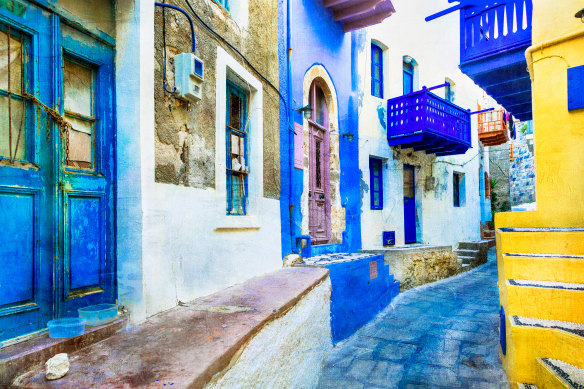
Into the blue … the streets of Nisyros.Credit: iStock
If you’ve never heard of Nisyros in Greece’s Dodecanese Islands, you’re missing a trick. Emerging from the Aegean like a lost Atlantis, the island is essentially one big volcano. Though just an hour’s ferry ride from Kos, barely a tourist sets foot here. With whitewashed cubic houses, blue-domed churches clinging to cliffs, hill towns rising out of lava, pumice and ash, healing hot springs and empty dark-sand beaches, Nisyros is Santorini without the cost, cruise ships or crowds. What a find. A still-active volcano, which last blew its top in 1888, is now the island’s showstopper. Trails wriggle up to its crater and beyond to oak forests, thyme-perfumed pastures, olive and almond groves, vineyards and silent coves pounded by the brilliant blue sea. There’s a sprinkling of sights, like Mandraki’s acropolis, clifftop crusader castle and cave church. But pleasures here are mostly simple ones: morning coffee at a kafenio, lazy taverna lunches and fireball sunsets on the west coast.
Essentials Dodekanisos Seaways ferry from Kos (50 minutes, $21). Porfyris Hotel has rooms from $65. See porfyrishotel.gr
Kythira
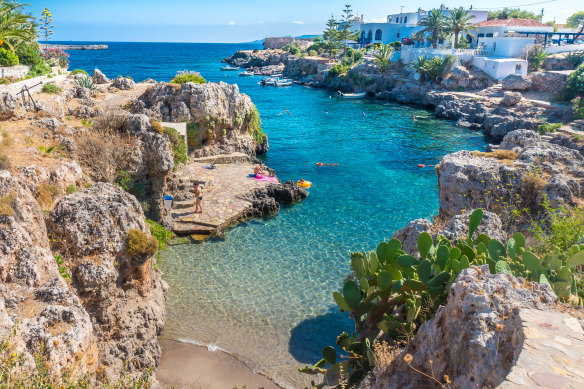
Kythira is Greece’s very own love island.Credit: Getty Images
Dangling off the Peloponnese’s southern tip and caught between the swirling blues of the Aegean and Ionian Seas, Kythira is Greece’s very own love island. Myth has it the beautiful goddess Aphrodite was born on the rock of Hyrta – sorry, Cyprus. And you might well believe it when you clap eyes on its loveliness. Despite its chalk-white, cube-stacked Cycladic architecture, Kythira is technically part of the Ionian Islands, but far removed from the cruise ships and crowds of Corfu and Kefalonia. Here, you’ll be bewitched by deep-cut gorges, beaches forming perfect golden smiles between high cliffs, a sea every shade of blue on the colour chart, and quiet country roads threading through olive, orchard and vine. While you’ll want to see the whitewashed, Venetian castle-topped Chora, the ghostly ruins of medieval Paleochora, the wispy Fonissa falls and dramatic Kalami gorge and beach, part of the deal here is finding a shady cove or taverna and doing diddly squat.
Essentials Triton Ferries runs daily ferries (one and a quarter hours, $18) between Neapoli in the Peloponnese and the east-coast port of Diakofti. In a charmingly restored 19th-century mansion, Hotel Margarita has ringside views of Chora with doubles from $65. See tritonferries.gr; hotel-margarita.com
Samothraki
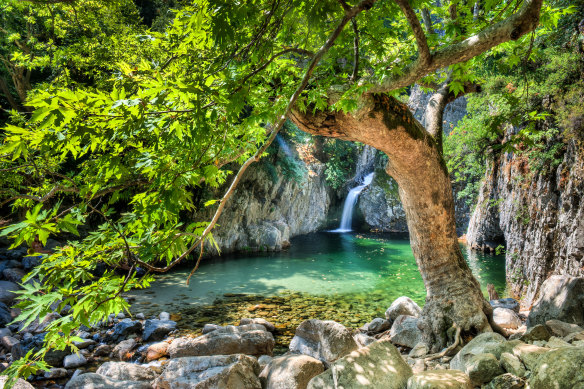
Waterfalls in Samothraki.Credit: istock
When sunset touches Samothraki like a golden caress, silhouetting high mountains and ruins, you can really feel the pulse of the island’s past. Out on its lonesome in the north-eastern Aegean, the island swirls in Homeric myth. Its crowd-puller is the Sanctuary of the Great Gods, a temple the Thracians built to worship early fertility deities around 1000 BC. It is one of Greece’s most enigmatic archaeological wonders. In the museum, you can gawp at an exact replica of the Nike (Winged Victory) monument that once stood here looking out to sea.
The original is now in the Louvre. You can see why the ancients loved this wild isle, with its deep forested, fern-flecked gorges, roaring streams and cascades (don’t miss the Paradeisos waterfalls). Above it all is the cloud-shredding, 1524-metre high Mount Fengari, the pew from which Poseidon watched the fall of Troy. Go for a hike or explore the cove-indented coast by boat, crash on a powder-soft beach like Pachia Ammos, or track down a ramshackle taverna to dig into the island speciality: goat.
Essentials Zante Ferries operates at least one daily ferry (one hour, 50 minutes, $24) from mainland Alexandroupoli during summer, Hilltop Samothraki Beach has sea-view doubles from $100. See zanteferries.gr; samothrakibeach.gr
Folegandros
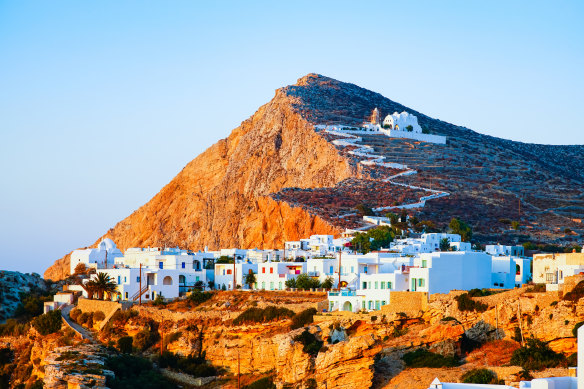
Folegandros’ biggest stunner is clifftop village Chora.Credit: Getty Images
Cast adrift in the southern Cyclades, Folegandros is often shunned in favour of nearby isles like Sifnos, Serifos and Santorini, leaving its drowsy beauty for those willing to go the extra mile. So do. It’s a vision of old Greece, with terraces staggering down to a sea unfurling like blue silk cloth and a road wriggling through countryside, past incense-filled chapels, braying donkeys and ancient ruins. On the south coast, there’s a parade of bays lapped by gin-clear waters that can only be reached on foot or by boat – Livadaki, Katergo and Agios Nikolaos among them. The island’s biggest stunner, however, is clifftop Chora, where the Byzantines and Venetians left their mark. Now it’s a thousand-year-old cat’s cradle of snow-white, bougainvillaea-draped lanes, with cafes on the cobblestones. Hike the zigzagging path up to the pearl-domed Church of Panagia (Virgin Mary), plonked above a ruined sanctuary where Artemis was once worshipped. The sunsets up here are surreal.
Essentials Seajets has twice-daily boats from Santorini to Folegandros (50 minutes to one and a quarter hours, $20 to $100). The Lemon Tree Houses in Ano Meria have slickly designed poolside, sea-view villas from $212. See lemontreehouses.com
Koufonisia
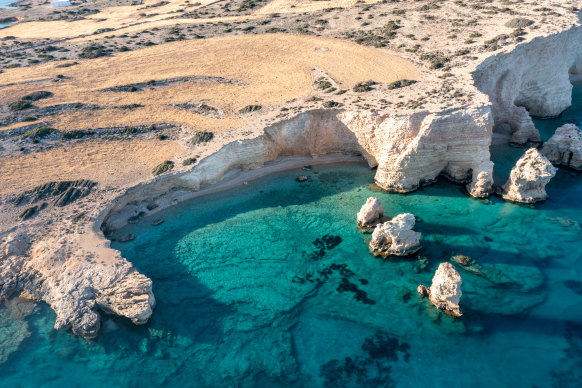
Koufonisia: the water here looks Photoshopped.Credit: iStock
Small is rather special when it comes to Koufonisia, the titchiest and most laid-back of the Cyclades. This crowd-dodger is actually a trio of islands – one inhabited, two not, all crazily pretty, with sugar-cube architecture and bare, sun-bleached hills. Running through every shade of blue on the spectrum, from aquamarine to deepest indigo, the water here looks Photoshopped. But real, it is. The island’s east is where the beach-hopping, snorkelling and diving gets exciting. Here you can tick off astonishing bays like rosary beads: Finikas, Fanos and Prani, with pale sands sloping into a sea that feels like you’ve been dropped into a cocktail glass of blue curacao. Like the Caribbean, but quieter. The best way to reach them is by hopping on a wooden boat from the port. For more solace still, boat it over to the empty beaches of Kato Koufonisi.
Essentials In summer, daily Seajets ferries link Koufonisia to Mykonos (one and a half hours, $80) and Santorini (two hours, $137). Architect owners designed six-room, minimalist-cool Teal Blue, which has dazzling sea views and doubles from $213. See tealblue.gr
Kastellorizo
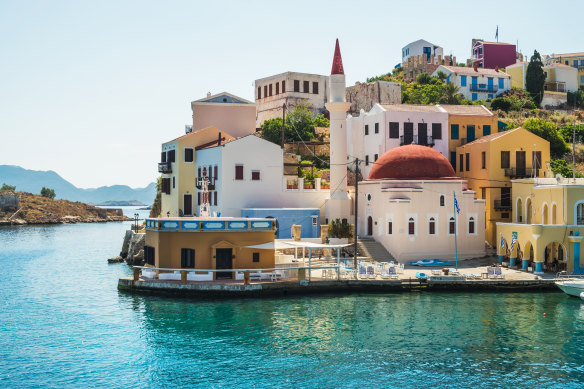
Houses and mosque on Kastellorizo.Credit: iStock
Gliding into the port of Kastellorizo by ferry is wondrous. With a minaret, ruined castle and riot of neoclassical mansions in Dolly Mixture colours reflecting in its exquisite turquoise bay, the island’s one and only town is a heart-stealer. At the easternmost fringes of the Dodecanese, Kastellorizo is just a wave away from Kas in Turkey – so close, in fact, that locals quip you can smell grilled kebabs if the wind is right. Pink Floyd guitarist David Gilmour fell so hard for the island when he stayed that he wrote the song Castellorizon. And nobody is immune to its charms – its history braiding together stories of the Ottomans, Byzantines, Romans, Crusaders, Egyptians, Turks and Venetians, its ancient Paleokastro fortress, and its mellow eastern light. Beaches? Not really. Too rocky. But you’ll never forget leaping off a boat into the sapphire waters of the stalactite-laced Blue Cave.
Essentials Blue Star Ferries call in twice weekly from Rhodes (three hours, $30). Dodekanisos Seaways ply the same route (two and a half hours, $55). Harbour-facing, boho-chic Casa Mediterraneo has seriously stylish suites from $357. See casamediterraneohotel.com
This story is an edited version of an article that appeared in The Telegraph UK.